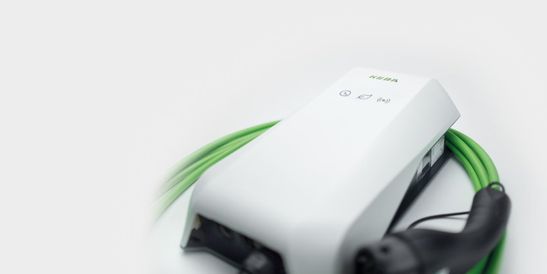Cable or no cable? That is the question.
- Knowledge
- Private
- Charging
- 1.12.2021
- Reading Time: {{readingTime}} min
- Share Article

Contents

Wallbox with charging socket – what does that mean?
A wallbox with a charging socket has no fixed charging cable. It has a slot into which to plug your charging cable to recharge your fully battery-electric vehicle (BEV) or your plug-in hybrid (PHEV). It is distinguished from a conventional wall socket that supplies a coffeemaker with power, for example, by the type of plug: A socket wallbox is compatible with the type 2 plug, which has become standard and is widely used.
Advantage of a wallbox with socket: more damage protection
A cableless wallbox is mainly used in public places. The reason for this is basically the principle of personal responsibility. If you use your own cable to charge your car, you will be careful to stow it properly afterward. With a fixed cable, the risk of leaving it on the ground and thus getting it dirty or even run over and damaged by another car is much greater. Moreover, a wallbox with a socket also allows for non-type-2-socket-compliant vehicles to be charged. The cable you bring along acts as an adapter from type 2 to the required format (e.g. type 1).
Of course, the contacts of a socket wallbox are not only protected by a cover but also guarded in such a way that there is no danger of touching the outlet if used properly. In some countries (e.g., France) the law stipulates yet another safety mechanism: the so-called shutter. This literal access restriction makes sure – similar to a child safety lock in a wall socket – that the plug only connects to the actual socket when it is fully plugged in. When the plug is pulled, the shutter immediately closes again.
Advantage of wallbox with cable: more comfort
The big advantage of a wallbox with a cable is that it’s more convenient to use. No need to dig out the charging cable from the (perhaps still full) boot of your car; no need to stow it away before your departure either. Pick up the plug. Plug it in. Done. Or: Pull out the plug. Hang it up again. Done. Either way, you’re done in a matter of seconds. And unlike a cable, which you might leave on the garage floor, a wallbox with a fixed cable won’t get your hands dirty. It doesn’t get any quicker or more convenient than that.
Note the cable length as you make your purchase
When you buy your wallbox with a fixed cable, pay attention to its length. It is usually between 4 and 6 metres. If the wallbox is well-positioned, a shorter charging cable is sufficient. But if your next e-vehicle has its charge port at a different position (e.g. a front port is about 5 metres from a port on the rear flank), the cable might already be too short. This could make your initial idea to save money quite costly in the long run.

























